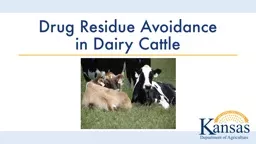

Drug Residue Avoidance in Dairy Cattle Dairy Industry Committed to producing safe and wholesome products Highquality milk and dairy products Continuous evaluation of quality management practices and disease prevention ID: 764095
Download Presentation The PPT/PDF document "Drug Residue Avoidance in Dairy Cattle" is the property of its rightful owner. Permission is granted to download and print the materials on this web site for personal, non-commercial use only, and to display it on your personal computer provided you do not modify the materials and that you retain all copyright notices contained in the materials. By downloading content from our website, you accept the terms of this agreement.
Drug Residue Avoidance in Dairy Cattle
Dairy Industry Committed to producing safe and wholesome products High-quality milk and dairy products Continuous evaluation of quality management practices and disease prevention protocols Top priority: judicious use of antibiotics Many precautions are taken so contaminated milk or meat never enter the food supply chain
Drug Residue vs. Illegal Drug Residue “Drug residue” refers to the presence of veterinary drugs or dewormers in meat. In dairy cattle, drug residue can also be found in the milk. “Illegal drug residue” is considered to be any drug found in an animal sent to slaughter that is above the allowable range.
What are the consequences of Illegal Drug Residue? Producers who are found guilty of illegal drug residue may face the following: financial penalties criminal penalties refusal at the sale barn and packing facilities or negative public perception
Human Health Risk Issues In the dairy industry, contaminated milk is a major concern for human health. Any adulterated product may result in the following: Drug residue allergies Development of antibiotic resistant bacteria Potential for cancer, reproductive or developmental effects Hormone-related risks
Residue Testing and Monitoring (Milk) The Grade A Pasteurized Milk Ordinance requires that all bulk milk tankers be sampled and analyzed for beta-lactam drug residues before the milk is processed. Positive test results lead to the mandatory testing of raw milk samples from each farm which supplied raw milk for that truckload.
0.014%
Residue Testing and Monitoring (Meat) In the dairy industry, culled cows are sent to meat packing facilities. Like beef cattle, these cows must follow all protocols set forth by the industry.
Prevention Practices Veterinary-Client-Patient Relationship Good Record Keeping Avoid Extra-Label Drug Use Proper Injection Techniques
Veterinary-Client-Patient Relationship It is important for a producer to have an ongoing relationship with an accredited veterinarian. This helps to ensure the veterinarian has assumed responsibility for making medical judgements regarding the health of the animal and need for medical treatment.
Record Keeping Should your operation get cited for a residue violation and you believe it’s a case of mistaken identity, good records are your only evidence that the animal in question does not belong to you. Records should include: treatment date, animal identification, name of employee administering the drug, drug administered, weight of animal, route of administration, disease being treated, withdrawal time and the first date the animal can be sent to slaughter. Records should be kept at least two years.
Avoid Extra-Label Drug Use Extra-label drug use (ELDU) is the use of an animal drug in a manner that is different from label instructions in regard to: the disease being treated route of administration of the drug dosage of the drug recommended treatment regimen It is important to follow all labeled directions and withdrawal dates.
Injection Technique Things to consider when giving an injection include: Administer the shot in the neck Inject subcutaneously when possible Make sure the injection site is clean Use the proper size needle based on: the location, route of administration, volume of injection and the thickness of the fluid Do NOT use bent needles
What is a Veterinary Feed Directive (VFD)? And What is their part in drug residue avoidance?
What is a VFD? A VFD is a written (nonverbal) statement issued by a licensed veterinarian that authorizes the use of a VFD drug in or on animal feed.
How are VFDs related to drug residue? VFDs are part of the FDAs strategy to reduce the amount of drug residue in the meat. It is an action to promote the judicious use of medically important antimicrobial drugs in food animals.
Summary Failing to practice good residue avoidance can lead to financial penalties and lead to poor public perception of the dairy industry. G ood management practices along with following withdrawal times on VFDs helps reduce residue at milking and packing facilities. Remembering tips like having a good VCPR, practicing accurate record keeping, avoiding ELDU and having proper injection site techniques results in better milk and meat quality in the end.
Contact Us Kansas Department of Agriculture (785) 564-6601 or (785) 564-6778 agriculture.ks.gov / animalhealth vfdinfo.org